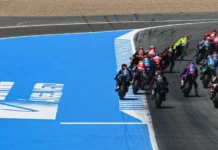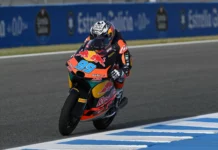Round 10: Sachsenring, Germany Track length: 3671 m Opened: 1966 Fastest Lap Ever: 1:24.056 (Alex Barros, 2004) MotoGP lap record: 1:24.056 (Alex Barros, 2004) Last year MotoGP winner: Max Biaggi 2004 MotoGP Race Summary Yamaha Factory rider and reigning World Champion Valentino Rossi entered the 2004 German Grand Prix, held at the Sachsenring with high expectations since the tight and twisty circuit has traditionally suited the nimble Yamaha. But after a determined fourth place in what was a dramatic and changeable race it was Max Biaggi (Honda) who mounted the podium as winner. Rossi’s fourth place came after an incident-filled race, and his team-mate Carlos Checa was one of many riders who did not make the finish. The Spaniard tumbled out on lap five, shortly after passing a string of riders. Rossi encountered his own challenges in the final laps, running wide on two corners and experiencing a violent weave as he tipped into the fast left hand curve at the top of the hill, losing places on each occasion after the rear tyre began to fade. Rossi chased the eventual race winner Max Biaggi in the early laps, sitting second and harrying his fellow Italian throughout. Sete Gibernau (Honda) closed in on the pairing until he fell from third place on lap eight, allowing fellow Honda riders Nicky Hayden and Alex Barros to move in on the act. Rossi broke Biaggi’s lead on lap 16, 0.7 seconds ahead at one stage, heading the order for a total of six laps. The young Italian’s challenge for maximum points faded, however, when he lost places consecutively to Biaggi, Barros and finally Hayden. Meanwhile massive misfortune visited the Fortuna Gauloises Tech 3 team when both riders crashed out on lap 21 of the 30-lap race. Marco Melandri lost control of his YZR-M1 when the rear wheel touched the grass. The bike highsided the young Italian into the air and then Norick Abe hit the stricken machine at nearly 200kmh, crashing spectacularly as a result. Both riders were circulating the 3.671km track in close company as they both tried to get the better of Honda runners Colin Edwards and Makoto Tamada. Marco and Abe were both well into the points places in seventh and eighth when the double disaster unfolded. 2005 Set-up report YZR-M1 The tight and twisty nature of Sachsenring lends itself to close racing. This is partially influenced by its rather short overall length, only just scraping in on the minimum allowed distance to host a MotoGP race, while the looping layout itself has the reputation of making passing moves on fellow competitors difficult even at the best of times. The design of the circuit, with virtually only three pieces of straight tarmac, has seen the MotoGP machines reach their top speeds at the back straight, with two key passing points – the final two left-handers. Like Donington Sachsenring is made up of low and high speed sections. For this reason the Yamaha YZR-M1 will need to offer agility and a degree of stability too – a difficult combination – although agility takes priority. For 2005 this has become a major strength with the re-born YZR-M1 and should provide each of the four Yamaha pilots an advantage. Due to the long radius turns, and the low speeds a smoother power delivery is especially useful at such an undulating circuit as much of the driving is done off the left side of the tyre. All of this with little camber on offer. To help the YZR-M1 in this regard Yamaha will opt for a more linear characteristic from the rear suspension linkage – to suit the needs of the circuit and the flatter torque characteristics likely to be used by the inline-four. Such a linkage ratio will offer a plusher movement through the first stage of the stroke before gradually increasing in intensity. It will not only improve traction off the turns, allowing the rider to get on the power harder and earlier than before, the new linkage should also reduce the effects of the M1’s front wheel pawing for the clouds. This is often an issue for the 240 plus horsepower 145kg machines. This will be supported with a rear shock set-up that sports a setting a little more on the softer side; offering more feel while working the rear tyre less over the bumpy surface. It is necessary, however, to ensure the swingarm motion is predictable, as these setting, combined with the undulating layout and lack of grip, can lead to instability. To prevent this from becoming an issue the shock’s damping will be dialed in to compensate, while the front forks will be set to provide the best all-round balance. This is possible with the limited amount of hard braking that takes place at the Sachsenring.
Yamaha Racing Previews The German Grand Prix
Yamaha Racing Previews The German Grand Prix
© 2005, Roadracing World Publishing, Inc.






